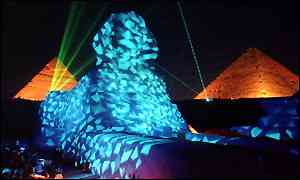 Past Press Releases
Past Press ReleasesWORLD CELEBRATES SUCCESSFUL RESTORATION OF THE SPHINX MAY 25, 1998.
By Dr. Zahi Hawass
Director, Pyramids of Giza and Saqqara
A spectacular laser show marked the
unveiling of the restored Sphinx
Before a select audience of international dignitaries and experts in the antiquities field, President Hosni Mubarak announced to the world on May 25 that the Sphinx is now safe-- and that it had been saved and restored by Egyptians. The celebration of the successful completion of the 10-year restoration of the Sphinx took place in front of the Sphinx itself, with the distinguished guests sharing their joy with the people of Egypt at this landmark event.
Egypt's Prime Minister Kamal E1-Ganzori and Minister of Culture Farouk Hosni assisted the President at the festivities with other Cabinet members. From now on, Mr. Hosni, under whose direction the Supreme Council of Antiquities (SCA) carried out the arduous, technically-demanding, decade-long effort to reverse the deterioration of one of the world's most familiar monuments, known as "the Minister for the Sphinx".
Among the roughly three hundred invited guests were Federico Mayor, Director General of UNESCO, numerous directors and curators of museums, including the Metropolitan in New York, plus Egyptologists and other scholars from around the globe, as well as media representatives and members of the Egyptian Parliament. Also present were First Undersecretary of Culture for Foreign Affairs Mohamed Ghoneim, Secretary General of the SCA Dr. Gaballah Ali Gaballah, Secretary of State and Director of the Culture Development Fund Samir Gharib, and Walid Awni, head of modern dance at the National Center and creative director of the evening's events which were broadcast live on television and radio.

A star-spangled cloak covered the newly-renovated
Sphinx prior to its unveiling
The celebration began when President Mubarak arrived at the Sphinx, built by Fourth Dynasty monarch Khafre (also called Chefren, 2475-2467 B.C.) whose facial likeness it bears. Khafre's pyramid is flanked by the Great Pyramid of Khufu (Cheops) and the lesser one of Menkaure (Mycerinus), both also Pharaohs of the Fourth Dynasty. This night the Sphinx, entirely covered with cloth for the occasion over its famous lion's body with a man's head, was unveiled by Egyptians dressed in Pharaonic style. When the covering was removed, Khafre's face once again gazed upon the world, smiling its immortal smile.
Then silence fell, and the Sphinx spoke in three languages, saying: With each new dawn I see the god rise on the far bank of the Nile. His first ray is for my face, which is turned towards him. And for five thousand years I have seen all the suns men can remember come up in the Sky.
I saw the history of Egypt in its first glow, as tomorrow I shall see the east burning with a new flame.
I am the faithful warden at the foot of his Lord--so faithful, so vigilant, so near him that he gave me his face for his own. I am a Pharaoh's companion, and I am he, the Pharaoh.
After this, a 12-minute film entitled "Sphinx 1998" was shown, detailing the process of the . Sphinx's restoration. The President then gave Egypt's First Class Award for Science and the Arts to Mr. Mayor, along with sculptors Adam Henein and Mahmoud Mabrouk, work foreman Said Hassan, and myself. Each person honored played a key role in the Sphinx's restoration.
After the award presentations, the Cairo Symphony Orchestra performed conducted by Dr. Mustafa Nagi. Then Dr. Nagi, who is head of the National Cultural Center (Cairo Opera House), led the orchestra in a ceremonial opening by Shostokovitch.
This was followed by extracts from the operas Carlo (with bass baritone Reda E1- Wakil), La Traviata (soprano Iman Mustafa), and Carmen (soprano Hana E1-Gindi).
The finale was Beethoven's Piano Concerto No.5, rendered by our renowned pianist, Ramzi Yassa.
Culture Minister Farouk Hosni was the the first speaker declaring,"The Sphinx endures as a symbol of life and a witness to history". In his address, UNESCO's Mayor added that "The Sphinx is a symbol of our common future and is a security for our future".
All those who attended received a bag containing a small silver statuette of the Sphinx, a book on the Sphinx and a videocassette copy of the film on the restoration as a special gift from Minister Hosni.
When the festivities had finished, I talked with two old friends about the grand spectacle we had just taken part in. One of them was Mark Linz, director of the American University Press in Cairo, who remarked, "The celebration was very successful. It is a message from President Mubarak to everyone all over the world that Egypt is safe. "Mark, a resident here for a number of years, continued," I feel safer in Egypt than any other place".
The other friend was Dr. Rainer Stadelmann who heads the German Archaeological Institute in Cairo. Rainer told me that he is very proud of the Egyptian team who restored the Sphinx in such a scientific manner, and that their skillful work had truly saved this priceless piece of our ancient heritage.
The radiant moment marking the end of this struggle against the ravages of time and the encroachments of the modern city was a message from our President that Egypt's monuments do not belong to us Egyptians alone, but to every human being. The great Sphinx of Giza is more than an emblem of the Egyptian nation, it is an archetype of antiquity whose image has stirred the imagination of poets, scholars, adventurers and tourists for more than forty-four centuries.
Now, thanks to its challenging restoration, we can say that the Sphinx will continue to awe its visitors for a long time to come.
Read the History of the Conservation of the Sphinx
Past Press
Releases:
Opening of tombs and
Queen's Pyramids in Giza